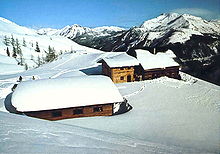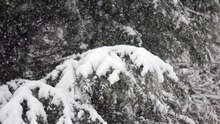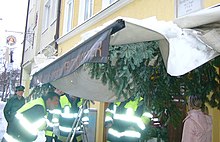Snow load
The snow load or snow pressure is one of the climatically conditioned variable effects on buildings . It depends on the type and amount of snow . The structural load assumptions with regard to the snow load for which a roof structure is to be designed depend on the geographical location and the shape of the structure under consideration.
Snow Weight Basics
Snow is frozen, mostly flat, crystallized precipitation , the density and weight of which primarily depend on the air temperature , at the time of snowfall - in the entire atmosphere height - i.e. also during the period of inactivity: It influences the form of crystallization and agglomeration. Snow usually forms a hexagonal star-shaped crystal shape, which can interlock to form large snowflakes while the snow is forming . When lying down, the snow changes to a highly complex structure due to the loading of further layers as well as recrystallization.
New snow has a specific gravity of 0.03 (dry, freshly fallen snow) to 0.2 (well-set new snow without additional water absorption). One meter of powder snow corresponds to an approximately five to ten centimeter high water column , with cardboard snow (wet snow) it is approx. 20 cm, which is 50–200 liters per square meter of precipitation (water equivalent). One cubic meter of water weighs one ton (1000 kg), one cubic meter of fresh snow weighs 30–200 kg, and longer-term snow often much more.
| Snow type | Mass per m 3 |
Snow depth at 100 kg / m 2 |
|---|---|---|
| Dry, loose fresh snow | 30-50 kg | approx. 200-300 cm |
| Bound fresh snow | 50-100 kg | approx. 100-200 cm |
| Heavily bound fresh snow | 100-200 kg | approx. 50-100 cm |
| Dry old snow | 200-400 kg | approx. 25-50 cm |
| Moist old snow | 300-500 kg | approx. 20-35 cm |
| Perennial firn | 500-800 kg | approx. 12-20 cm |
| ice | 800-900 kg | approx. 11-12 cm |
- Source: Lower Austrian Civil Protection Association
Snow load generally acts as a surface load perpendicular to the base . For static evidence, with respect to the design load of simplicity - and lying on the safe side - with wet snow, and a density (specific gravity, weight force per volume) of 2 k N / expected m³, which is about the above value for strongly bound Fresh snow.
As a general word in relation to landscape (e.g. forest or ecological), snow pressure is synonymous; in terms of construction, it would specifically mean the weight force or, more precisely, the force per contact surface, i.e. the actual surface pressure .
Of course, when the snowpack as such does not become heavier, it only reduces its volume. In fact, snow becomes lighter while lying down, both when it is warm and when it is very cold after it has fallen: In the first case, snow melts, seeps through the pores and runs off, in the second case, the water sublimates ("evaporates") directly into the air . This is also favored by sunshine and dry air. From a structural point of view, even several meters of dry fresh snow on technically perfect roofs are not a threat. Heavy snowfalls at around zero degrees are problematic, because very heavy snow falls by itself, and even more rainfalls in high snow cover. Then large amounts of water can also be bound in the snow cover, and the snow load is actually many times higher, which can lead to spontaneous failure of a roof. This can happen in a very short time, in the range of a few hours. Therefore, long-lasting cardboard snowfalls and heavy snow turning into rain represent acute crisis scenarios.
Norms
In Germany , snow loads are regulated by DIN EN 1991-1-3 (2010-12) and the associated national annex.
In Austria , the load-bearing capacities of building cladding were newly specified by law in April 2006 by ÖNORM B 1991-1-3: 2006-04-01, with the values being increased significantly.
Both the Austrian and German new regulations are based on the European standard EN 1991-1-3. They apply up to heights of 1500 m ; higher altitudes are regulated by special national annexes.
In Switzerland , SIA 261: 2003 is to be applied.
Calculation according to standard
In the standards , the snow loads are converted into calculated values to determine the structural safety. Due to the strong physical and temporal fluctuations, the pronounced stochastic character is taken into account. The calculated values correspond to the 98% quantile of the annual maxima and thus a mean return period of 50 years.
Location
The decisive influencing factors on the size of the snow loads are those of the location with the local climatic zone and the topographic height . In the standards, the snow climate is recorded by a map of the snow load zones, which indicates the snow intensity for different geographical regions.
In Germany there are the Scheelastzone
- Zone 1 (including the Middle Rhine Valley , Lower Rhine Plain )
- Zone 1a
- Zone 2
- Zone 2a (high Black Forest , Rhön and Sauerland )
- Zone 3 ( Alps , Bavarian Forest , Thuringian Forest , Ore Mountains , Harz and Western Pomerania ).
Since the snow depth increases disproportionately to the altitude, this must be taken into account as a further influencing factor. This results in the following characteristic values of the snow load in kN / m² on the ground, to be applied at the location , depending on the terrain height A in m above sea level (see diagram):
- Zone 1:
- Zone 1a: Multiplication of the s k value from Zone 1 by the factor 1.25
- Zone 2:
- Zone 2a: Multiplication of the s k value from Zone 2 by the factor 1.25
- Zone 3: For certain locations in Zone 3, higher values than the equation given here may be decisive; Information on the snow load in these regions must be obtained from the responsible authorities.
For snow load zones 1 and 2, in the northern part of Germany, the northern German lowlands , the calculated value of the exceptional load case is multiplied by a factor of 2.3 in certain locations; Whether a place belongs to it can be determined in the technical building regulations of the federal states or in the snow load zone table of the German Institute for Building Technology (see web links).
Building geometry
The roof shape or roof slope of a building is another parameter for the snow load and is taken into account by shape factors . These describe the relationship between the amount of snow lying on the roof and the amount of snow that has fallen. B. that the snow slips off a steep roof faster than a flat one.
The size and distribution of the snow load can also be strongly influenced by the wind conditions. Snow drifts often form on jumps in height , which must be observed.
Standard value
The snow load to be applied to the structure follows from the local (characteristic) snow load multiplied by the shape coefficient :
Measurement
A measurement using a folding rule and specific weight (standard weight) is not sufficient, because the snow density and icing are not taken into account. Therefore, a snow sample is taken with a SPER (snow sampling tube) and weighed. The sample taken is then examined for snow density, degree of icing and water content . At least three samples are taken for the evaluation and evaluated using calculation software. Then the real snow load is compared with the calculated snow load and the stability of the roof structure is assessed by an expert .
Further tools are e.g. B. Snow load scales .
eviction
If the calculated snow load is reached or exceeded, a roof should be cleared . This is best done in sections and alternately in strips on the roof surfaces.
In addition to conventional clearing, the melting of the snow with hot steam is successfully used. The snow surface to be melted is covered and heated with steam.
Extreme events
Due to economic considerations, extreme snow loads, which only occur very rarely, are not recorded in the standards.
For example, in parts of the Alpine region and the Bavarian Forest, in the long, extremely snowy winter of 2005/2006, the actual snow load according to the standard was significantly exceeded. This applied to the load assumption specified in DIN 1055-5: 1975-06, which was introduced by the building authorities in Germany at that time ; the new version of the ÖNorm had just been announced but was not yet in force. Therefore, the roofs had to be cleared for safety reasons in order to avoid failure from the snow load.
It turned out that the snow loads on roofs were often not given enough attention at the time. In contrast to the information about the avalanche situation , the building supervisory authorities and weather services did not provide qualified information to construction experts and house owners about the current snow loads , even if the local standard loads were exceeded by larger amounts. At the event in 2006 , the ice rink in Bad Reichenhall collapsed on January 2nd under a snow load that did not exceed the standard requirements ; 15 people were killed. A few weeks later, the roof structure of the exhibition hall in Katowice failed, killing 65 people. While these events were initially regarded as isolated cases, the situation changed a little later when numerous roof trusses collapsed under large amounts of snow in many places in Bavaria , Upper Austria , Styria and Lower Austria .
For this reason, the modeling and forecasting of snowfalls has been significantly improved in recent years, both with regard to the large-scale medium-term forecast and much smaller hotspots. When snow event in 2019 (several days in the area) was an early warning and provided by the crisis teams auxiliaries for the preventive Abschaufeln.
Web links
- Free online tool for determining the snow load zone and the characteristic value of the snow load s k according to Eurocode (also wind zones, earthquake zones)
- Instructions for estimating the snow load of a current snowpack (PDF file; 63 kB)
- Snow load according to standard: DIN1055.de | Load assumptions for users
- Calculate snow load according to DIN1055 online
- Information about snow loads in Austria
- THW OV Witten, snow load measurement
- Deutsches Institut für Bautechnik: Snow load zones in Germany
Individual evidence
- ↑ Heavy snow: How heavy is snow actually? Lower Austrian Civil Defense Association, noezsv.at, accessed January 11, 2019.
- ↑ Influences on structures - supplementary specifications (SIA 261/1: 2003 building industry). (PDF) Retrieved January 15, 2016 .
- ↑ Implementation report "Melting snow with superheated steam", December 2011: Steam against snow - reducing roof load by melting , author: Duchten-Dampfkessel-Blog. Retrieved February 14, 2011.













